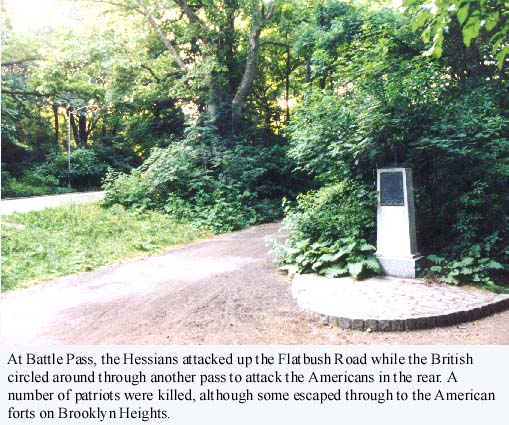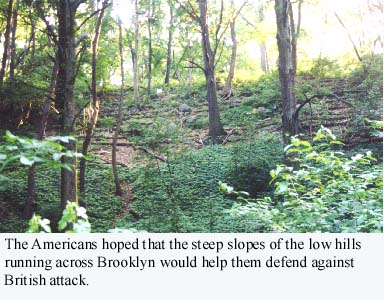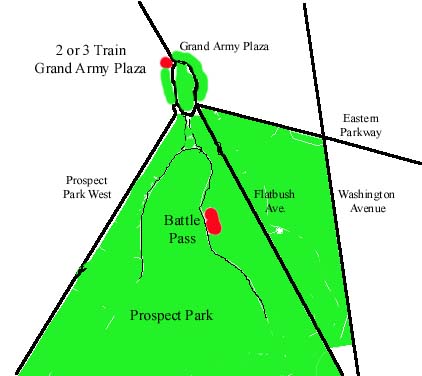Americans Held Back Hessians Until
British Attacked From The Rear

Battle Pass
Americans Held Back Hessians Until
British Attacked From The Rear

The Battle of Long Island was the largest of the American Revolution and the first fought after the Declaration of Independence.
While an American defeat, it helped to establish the pattern that would eventually win
the eight-year war for the Americans. The British, with superior transportation, supplies
and training, could mount an attack on almost any American position. Although the British
could take the ground, they would suffer casualties and fail to annilate the American
army, requiring the British to prepare for another battle. This steadily eroded the king's
purse, demoralized the soldiers, turned public opinion at home against the war, encouraged
England's enemies abroad and allowed Americans to receive the training and develop the
tactics that resulted in ultimate victory. 
Washington, in Manhattan, had left much of the preparation of the defenses in Brooklyn to subordinates. In a sense, the Americans had become victims of their own success in the Battle of Bunker Hill outside Boston. They expected the British to greatly underestimate their abilities and attempt a frontal assault on a fixed position. While the British still underestimated the Americans, they were not ready to repeat the costly mistake of Bunker Hill. The American commanders, constantly changing, in ill health and poorly trained, were not prepared for the type of feints and maneuver that the British launched. Far from being aliens in a foreign land, many of the British officers had spent much of their careers in America, sometimes knowing the ground better than the Patriot generals brought in from other Colonies.
When the British decided to attack New York, they first landed on Staten Island and
then came across to Brooklyn, landing at Gravesend Bay. While many of the American
soldiers were in relatively strong positions in Brooklyn Heights, the front line was on
the low line of hills running from the Harbor through Greenwood Cemetery and Prospect
Park.
On the day of the battle, Aug. 27, 1776, Israel Putnam was in overall command of the
10,000 American troops on Long Island.General John Sullivan was in command of the advanced
position with 3,500 men on the low hills. Gen. William Alexander, who preferred the title
Lord Stirling, was in charge of the troops along the Gowanus Road near the Harbor.
Unfortunately for the Americans, there were only tiny units at the passes to the east,
especially on the Jamaica near East New York/New Lots.
About 1 a.m. the British attacked Stirling's advanced positions and he moved to reinforce
his outposts, stopping the English advance at about 3 a.m.
At Battle Pass, the Americans had chopped down a large oak tree to block the Flatbush Road
where it went through the pass. The Americans were also dug in higher up and flanking the
pass. The Hessians, as the German mercaneries were called, began a cannonade of the pass
defenses about 1 a.m.
When General Sullivan arrived about 8 a.m., the Germans were still firing their guns, but
the Americans were holding their ground.
The Americans first learned of impending disaster at 9 a.m. when the British, who had
marched into their rear, fired two guns as a signal to the Germans to launch a coordinated
infrantry attack from the front of the Americans in the pass while the British closed in
on the rear.
The British flanking expedition had started about 9 p.m. the previous night. They marched
through the Jamaica Pass to the east and found it guarded by only a few men who were
easily overpowered.
Now surrounded, the Americans in the pass fought desperately. Some tried to surrender, but
because of language and cultural differences, many were executed outright. The Americans
fought past the time when the Germans thought it would have been appropriate to surrender,
and in the German mind, lost the opportunity to do so. Many Americans found themselves
surrounded in the woods by rings of Hessian troops who closed in for the kill with
bayonets.
Some Americans were able to fight their way past the British before the envelopment was
completely closed. The fleeing patriots headed back toward the American lines on Brooklyn
Heights.
For more on the Battle of Long Island, please turn to the Old Stone House and Battle Hill.
Address: Prospect Park, just in from the north edge of the park
between Grand Army Plaza and the Brooklyn Museum.
Borough: Brooklyn
Transportation: Trains 2,3, Grand Army Plaza or Eastern Parkway. (From
Fort Greene, take the 2 or 3 from Nevins Avenue to Grand Army Plaza, walk into the park
and toward the Brooklyn Museum, keeping parallel to Eastern Parkway.)
Area Map:
